THE CAPTURE OF
SAINT-LÔ
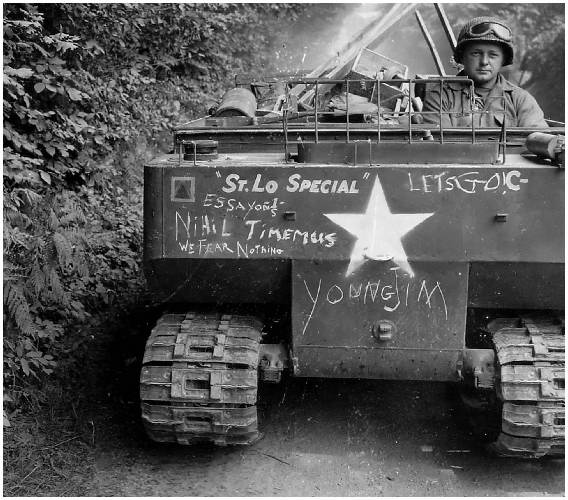
Two weeks after the landings in Normandy the Americans had
a secure bridgehead. The attack on Cherbourg was in progress.
But the outbreak to the south encountered heavy opposition
from the Germans. Every house, village or town needed a hard
fight. There was a roughly frontline to draw from Montebourg
in the north, via Carentan, Isigny, Trevieres, Bayeux, the
north of Caen and the east river bank of the Orne near
Ranville.
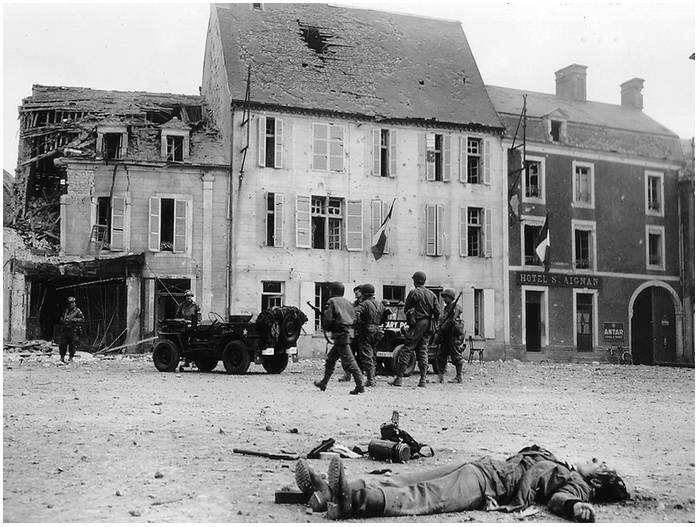
Left, Trévières,
June, 1944 and (right) the serene silence of the
present.
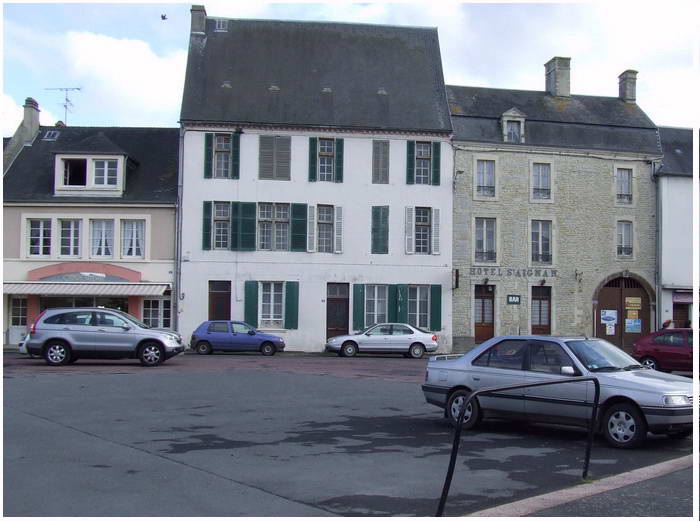
It was not only the Germans that slowed the progress of the
Allies, also the terrain was a struggle to come by. The 7th
Army Corps was slowed down because of the swampy terrain's
around Carentan, and the 19th Army Corps had to find a way
around the hedges, the so called 'bocage'. If he wanted to
have the greatest benefit of his tanks and other motorised
units, General Bradley had to find a way to break out of this
terrain.

General Omar
Bradley (left) and Maj.Gen. Lawton Collins
talk on the capture of Cherbourg
The road Saint-Lô to Coutances seemed the best option.
Saint-Lô was heavily defended. On 3 July the Allied 8th Army
Corps made their first attack. But the bad weather and the
German defence stopped the progress after 5 kilometres in
three days! Meanwhile the 7th Army Corps headed on the 4th of
July from Carentan to Périers. These troops did even worse, in
three days they only managed 2 kilometres. The 19th Army Corps
opened their attack on Saint-Lô on 7 July. These troops had as
their first target the hills east of the town. Strong German
units were unbreakable, especially in the north-east at 'Hill
192'. In the morning of 11 July, at 05.00 hours a barrage of
fire from artillery opened up, an hour later the field cannons
joint in.
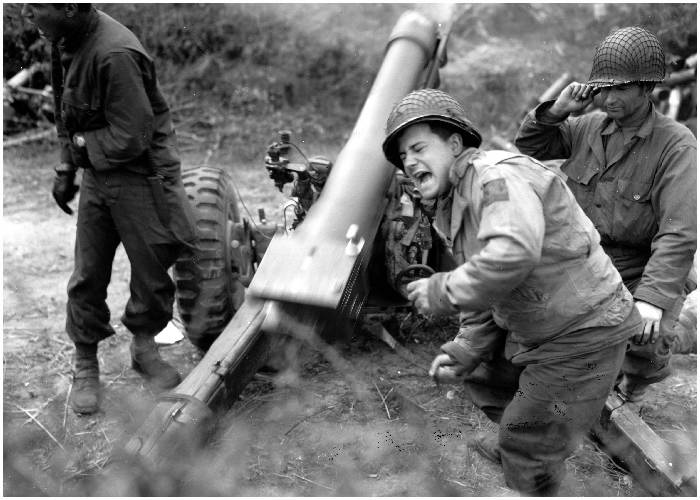
Field battery's open
fire at 'Hill 192'
After every barrage of four minutes the units moved 100
metres forward. In the hail of grenades and bombs the Germans
had to stay put in their tunnels that were dug into 'Hill
192'. They had no change to return fire. Finally American
engineers blew up the tunnels and covered the surviving
Germans under one and a half metre of earth.
OPERATION
COBRA
General Bradley planned to make a break to the south around
July the 20th. But before he could make that move, he had to
secure Saint-Lô. An operation code name was given on 13 July,
'Operation
Cobra'.
After the massacre on Omaha Beach and the breakthrough towards Saint-Lô, almost the whole of
29th Division was replaced by fresh troops. The attack on Saint-Lô was planned for July 17.
Leading the first attack was Major Thomas D. Howie, commander of the3rd Battalion of the 116th
Regiment, 29th Division, and connected with the 2nd Battalion, ordered his men to fix the bayonet
to the rifles and keep hand grenades at the ready. From every platoon, only one in two was given the
order to fire it, it had to be a surprise to the Germans that there were is twice as much troops than
they expected. At the first light, the first troops of the 29th broke through the German lines,
occupied the high ground, just a kilometer from Saint-Lô.
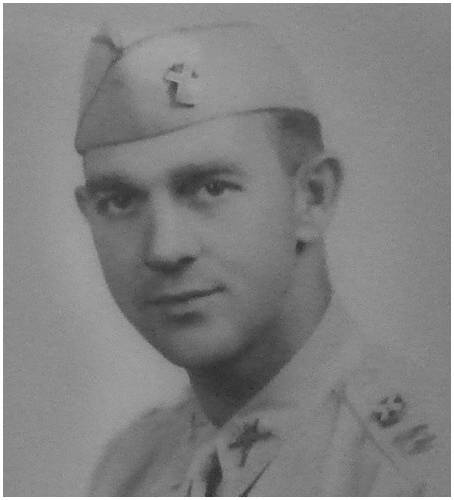
Major Tom Howie
Major Howie had a meeting with the company commanders to conduct the next step. When the meeting
broke up, German mortars started falling down among the officers. When Howie checked every men was
in hiding, a mortar exploded near him, and a piece of shrapnel planted itself in a lung of Howie.
Two minutes later, Howie died in the arms Captain William Puntenney.
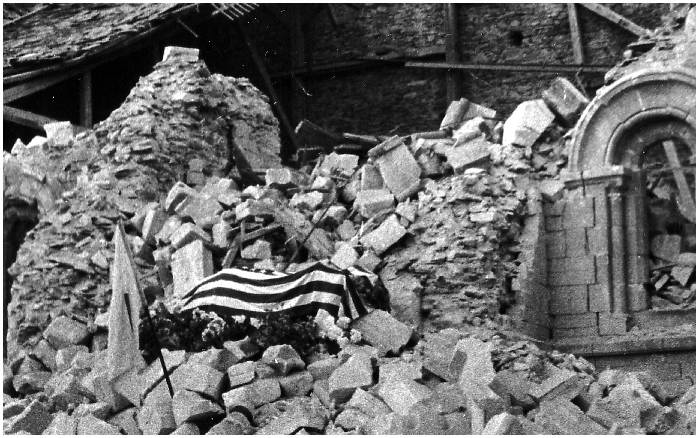
Major Tom Howie his body is covered
with the Stars and Strips
After the barrage had stopped, German Fallschirmjäger attacked the battalion. But the American
artillery and the called in fighter-bombers prevented an overrun. The men of Howie took after
that the town of Saint-Lô, only to see that the town was completely destroyed by the American bombers.
There was some scattered fighting Fallschirmjäger before the town was secured on 18 July.
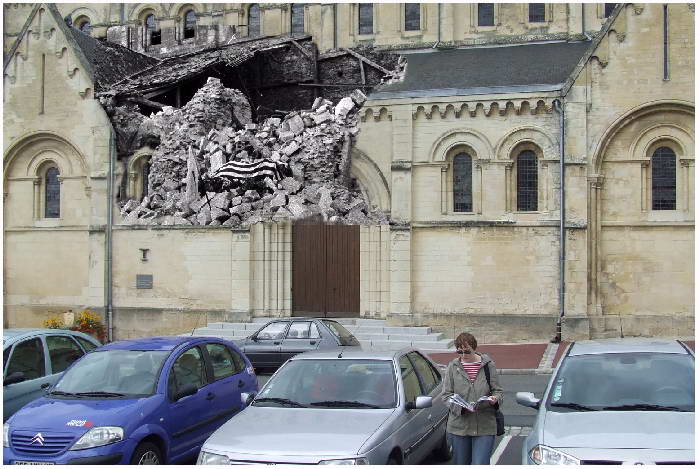
De Saint Croix with the Major Tom Howie
(the church is after the war restored)
General Gerhardt, commander of the 29th Division, ordered to bring the body of Major Howie to be
brought into Saint-Lô on the hood of a Jeep. Here it was placed atop of the rubble of the Saint Croix
church and covered with the Stars and Stripes. Citicens from Saint-Lô brought flowers, and the body
stayed there until 19 July.
Cornelius Ryan, famous writer for the book 'The Longest Day (amog others),wrote a piece of the
incident for the Collier's Magazine on the first American in Saint-Lô, under the headline
of The Major of St. Lo
(the name was not given free for some time by the American Army).
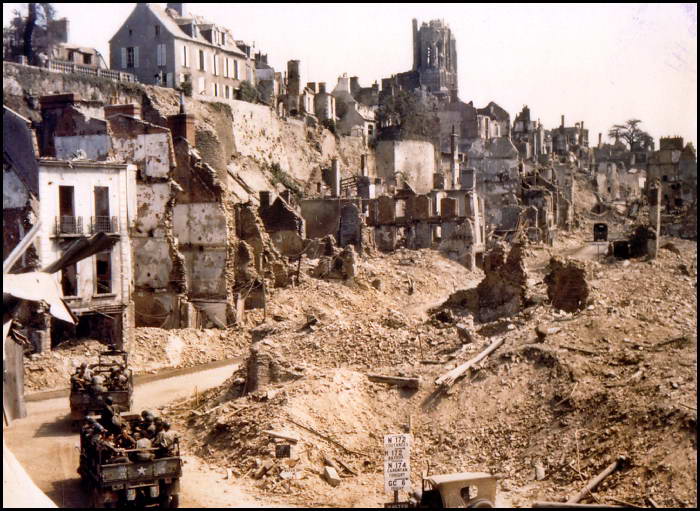
Saint-Lô in ruins
The town of Saint-Lô was totally destroyed,
but there was a new frontline. Roughly from Lessay, on the west
coast, via Saint-Lô, to Caen. This became the starting line of
the new operation. On 19 July Bradley leaves for England to
discuss his plans. He wants a preliminary bombardment south of
Périers to Saint-Lô, a rectangle area of 7 km width and 2½
deep. Bradley suggest light bombs to avoid unnecessary large
bomb craters that could slow down his tanks. Further more, he
wants the ground troops just 800 metres from the starting
line, and demands therefore accurate dropping by the airforce.
But the commanders of the airforces want to fly a route
south/north to avoid the heavy flak and they like to see that
the troops on the ground are at least 3000 metres behind the
starting line, they fear otherwise for casualties on the
American troops. This is way too far back in the opinion of
Bradley. After an endless debate they agree to pull the troops
1450 metres back. A total of 2500 planes are to participate in
the attack. They will drop 5000 tonnes of high explosive,
phosphor and napalm bombs. Due to bad weather, the date for
'Operation
Cobra' was postponed from 20 July to 24 July.
Unfortunately, on that day, the bad weather obstructed a precision
bombardment. They tried to call the bombers back, but only a
part of the planes received the message. 300 bombers executed
their mission. The outcome was disastrous. Bombs were scattered over a
large area and even were dropped behind the starting line. They had
hit the waiting American troops and killed at least 25 men and
131 wounded. Because the Germans were 'woken up' by this
preliminary bombardment the American troops were stopped in their advance.
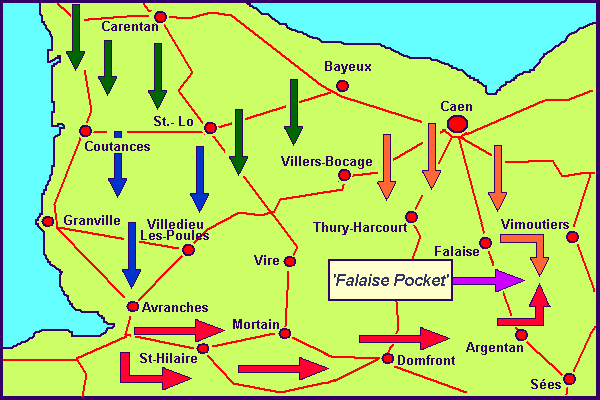
Green and blue arrows
show the route for 'Operation Cobra'
The next day, 25 July, 1500 heavy bombers and 550
fighter-bombers once again bombed the whole area. Once again
were not only German troops hit, the local people suffered
heavily and the Americans got again their share of the 3500
tonnes of their own bombs. Lieutenant General Lesley McNair,
commander of the American ground force was killed during this
bombardment. On 26 July the tanks moved forward to start the
offensive on the ground. The 1st Infantry Division heads for
Marigny. But the progress was slow due to the heavy defence put
up by the Germans, the advance was stopped 1.5 km before they
reach Marigny. It was a long way to Coutances. At the left flank
the progress was somewhat smoother. Fighting Group-A advanced
rather fast without to much resistance. In the afternoon the
troops arrived in St-Gilles and head straight away for Canisy.
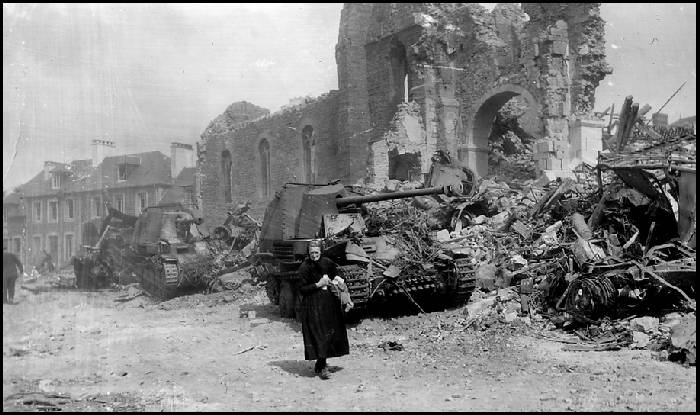
In Roncey retreating Germans were hit hard
Then and Now
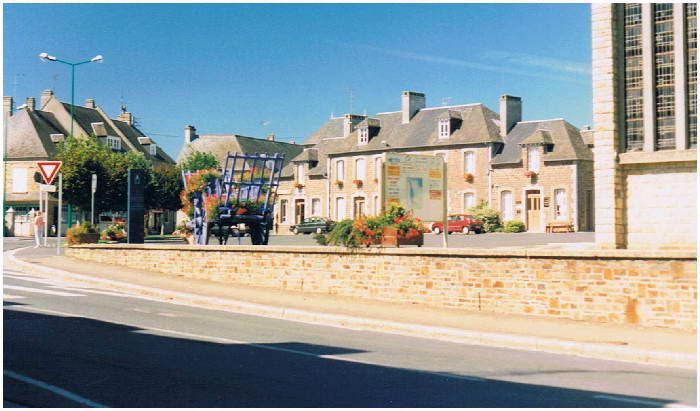
But the advance to Coutances from Saint-Lô was a struggle. The
hedges of the bocage slowed down the attacking troops terrible.
These delays were a benefit to the German troops. Almost all of
the German units of the 84th Army Corps, under the command of
von Choltitz, retreated from the west through the thin line of
southwards advancing Americans. But the retreat was sometimes
chaotic, long columns were stuck in the small villages and on the
small roads. In the town of Rocey such a German column was under fire
for at least six hours by Allied planes. Over 100 tanks and 250
other vehicles were destroyed. German troops were on the run and
pulled back to the south and east.
THE FALL OF AVRANCHES
Bradley decided not to consolidate or
to give the men a rest. He pressed the troops to head for
Avranches. From there they would turn inland east and press on for
Mortain and entangle the Germans. Montgomery meanwhile was
ready to break out of Caen to bring pressure on the Germans
from the north. The Allied command could not yet foresee that
this would lead to a destructive pincer movement. The Allies
where unaware that Hitler was planning a counterattack, and to
drive more German troops into the trap. General Patton was
appointed to lead the 3th Army. First he pulled back the
infantry and ordered the 4th and 6th Armoured Division to keep
the pressure on the Germans.
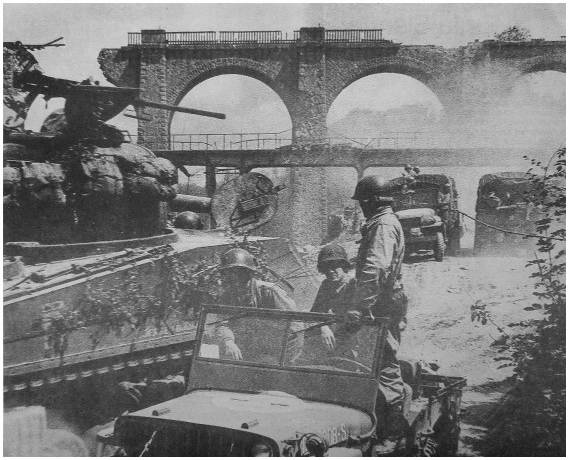
Coutances was liberated on 28 July
Then and Now on the D7
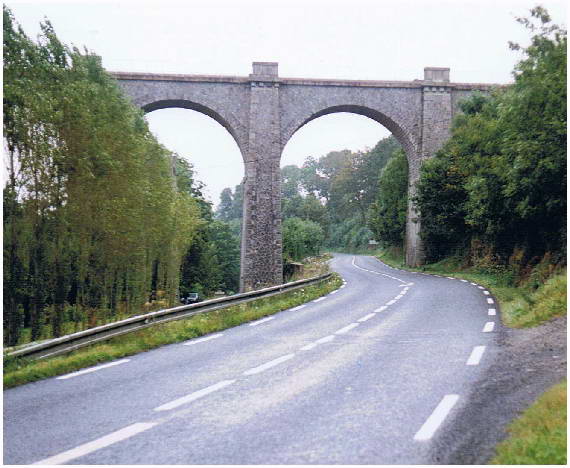
Finaly Coutances was liberated on 28 July. Now the town had
fallen into American hands, the road to the south was open, and
the troops headed for Avranches. On 29 July the American troops
role into Avranches, it was lightly defended. A pleasant
surprise because of it's strategic importance. Avranches was a
junction of several roads. During the celebration of the
victory the Americans found themselves in a nasty predicament.
On the coastal road approached a German column, some vehicles
wore a red cross. Convinced that this was a transport of
wounded, the American let them pass. Suddenly the 'wounded'
opened fire from there vehicles. The response of the Americans
was quick, the Germans surrender when they saw the predicament
they were in. When the Americans troops 'resolved' a few more of
these 'encounters', Avranches was and stayed in firm hands.
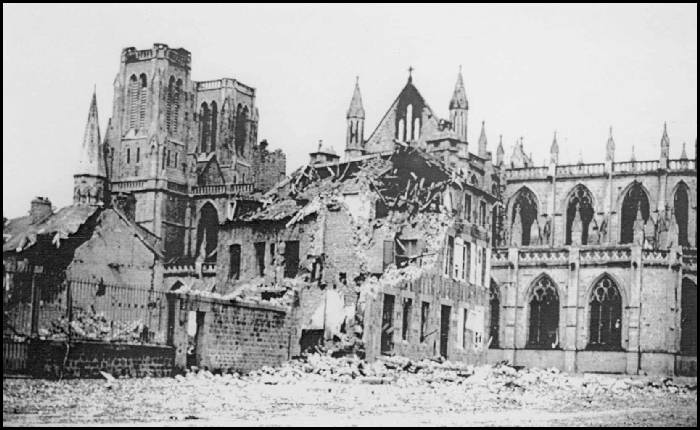
Avranches 1944, no
signs of destruction today
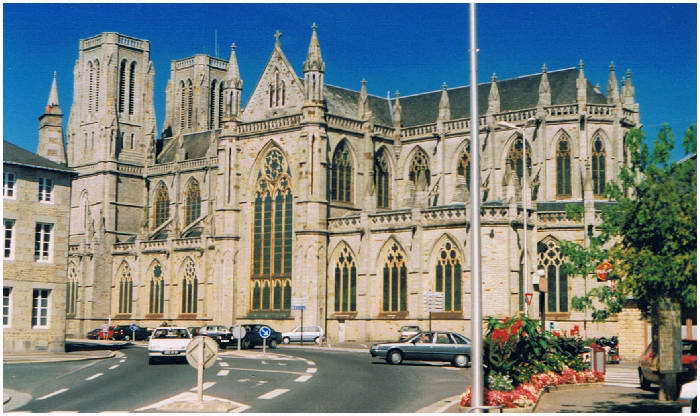
But the Germans realised that the American frontline to the
south, was extreme thin. Before the line is re-enforced they
have to counter attack. Thanks to the action performed by
Patton, the fall of the west-coast of Normandy was quick.
Without hesitation Patton moved southwards with his tanks.
Lower rank officers got their orders roughly and could make
there own decisions, and were allowed to improvise. This was
one of the reasons of the quick decent to the south. Every
junction had a high officer that was directing the traffic.
Pattons tanks swarmed into Brittany while the German bombers
were kept at distance with anti-aircraft guns. In 72 hours
seven division moved over the road from Avranches into
Brittany. But Brittany became a target of less importance and
later on, only one army corps stayed in that area.

An M4 Sherman tank in Avranches as monument
Target Avranches seemed into reach for the Germans. But
'Hill 317' was in a firm grip by the Americans. The Allied troops were
not sure of this attack was for real, and hesitated to accept
reinforcements of 4th Armoured Division. But if Avranches
would fall into German hands, the First and Third Army were
threatened to be split. Fighter-bombers were sent in and
destroyed at least forty of the seventy German tanks that had broken
through. For the German troops, that were dug in around Mortain, it
was a shock to learn that 600 British and Canadian tanks were
on their way to Falaise. German tank units that were needed in
the west and south had to stay in the northern sector. A
bigger problem arose for the Germans units that were in an
offensive action against Avranches. They were threatened to be
encircled, so they had to retreat. On August 11th the
counterattack on Avranches was cancelled.

Monument in the heart of Avranches for General Patton
ARE THERE ANY TRACES
LEFT?
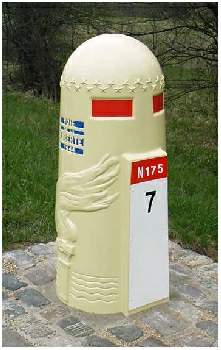
After the war the great rebuilding started so there is not
much left that reminds us of the fierce fighting that took
place around these parts of Normandy. Everywhere are monuments
and memorials and on the route to Avranches you'll notice the
well known markers beside the road (see the home-page with the
00-marker at UTAH Beach).
To continue the battle and the closing at the 'Falaise
Pocket';
'CLICK HERE'
|